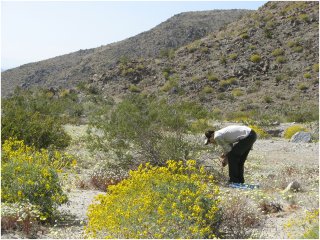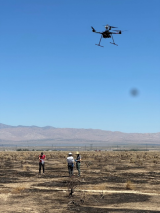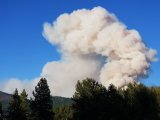EPA Research in California

EPA researchers are working hard to protect communities across the nation. Learn about some of the work EPA researchers are doing in California.
- Using Drones to Sample for Valley Fever
- EPA Office of Research and Development Scientist Responds to the McKinney Fire
- Reducing Harmful Air Pollutants
- EPA Grantees Advance Air Monitoring Sensors to Protect Public Health
- Los Angeles Public Library Air Sensor Loan Program
- Protecting Building Occupants from Wildfire Smoke
- Helping Community Drinking Water Systems Impacted by Wildfire
- California Aquatic Environmental DNA
- Water Reuse Technologies
- Stormwater Best Management Practices
For more EPA work, see EPA in California.
Using Drones to Sample for Valley Fever

Valley fever is an infection caused by inhaling the Coccidioides fungus, which lives in soils in the western United States. In 2023, EPA researchers received Pathfinder Innovation Project funding to deploy drones to collect air samples of Coccidioides spores. As a proof-of-concept test, the team flew drones equipped with biological sampling devices over known, non-wildfire Valley fever hotspots in the San Joaquin Valley, California. Read High-Risk, High-Reward Research with EPA’s Pathfinder Innovation Projects.
EPA ORD Scientist Responds to the McKinney Fire

In 2022, a lightning-induced wildfire in Klamath National Forest in Northern California quickly grew to more than 50,000 acres. Soon after, EPA Office of Research and Development (ORD) scientist Dr. John Iiames traveled to Yreka, California, to lend his expertise in air quality and smoke modeling and serve as an Air Resource Advisor to the response team. Read EPA Scientist Serves as Air Resource Advisor on the McKinney Fire Modeling Smoke and Air Quality.
Reducing Harmful Air Pollutants
For more than 25 years, EPA and states have been using ORD's Community Multiscale Air Quality (CMAQ) Modeling System, a powerful computational tool for air quality management. CMAQ simultaneously models multiple air pollutants, including ozone, particulate matter, and a variety of air toxics to help air quality managers determine the best air quality management scenarios for their states and communities. The California Air Resources Board uses CMAQ to develop and assess implementation actions needed to attain National Ambient Air Quality Standards mandated by the Clean Air Act.
EPA Grantees Advance Air Monitoring Sensors to Protect Public Health

EPA grantees developed a toolkit to help California communities select, use, and maintain low-cost air sensors and interpret the collected data. The grantee research team engaged, educated, and empowered communities to understand the benefits of using low-cost air sensors to track air quality. Read EPA Grantees Advance Use and Applications of Air Monitoring Sensors to Protect Public Health.
Los Angeles Public Library Air Sensor Loan Program
Air quality in the Los Angeles area has improved over the last four decades, but the area still struggles with air pollution which contributes to asthma, cardiovascular disease, and other health problems. Communities have become interested in using new, lower-cost air sensors to measure air quality conditions at the neighborhood or street level. ORD, in collaboration with EPA Region 9 and the Los Angeles Public Library, developed an air sensor loan program. In addition to books, library patrons could check out an air sensor device for free.
Protecting Building Occupants from Wildfire Smoke
ORD is working with local and Tribal partners, including the Hoopa Valley Tribe in California, on a solutions-driven research effort to address reducing indoor air exposures to wildfire smoke. One of the concerns raised by partners was that they had no guidance to use when they talked with building owners about how to improve indoor air quality during wildfire smoke events. EPA collaborated with the National Institute of Standards and Technology and the American Society of Heating, Refrigerating and Air-Conditioning Engineers to develop a guidance document for commercial building owners.
Decontaminating a BART Railcar

Release of biothreat agents, such as Bacillus anthracis spores, by terrorists into an underground subway system could have devastating impacts on human health and the functioning of cities. ORD scientists, in conjunction with partners, evaluated how well methyl bromide treated a Bay Area Rapid Transit (BART) railcar contaminated with anthrax spores.
Cleaning Up a Subway Contaminated with Anthrax

ORD is a leader in improving the nation’s ability to cleanup buildings contaminated with anthrax or other biological agents. In recognition of the complexities that would be involved, and the number of cities that have underground rail system, EPA along with Department of Homeland Security, Department of Defense and several national laboratories turned their attention to the cleanup of subway systems contaminated with anthrax. At Fort A.P. Hill, researchers evaluated decontamination technologies that could be used in the event of an anthrax incident in a subway system.
The Yurok Tribe Assesses Environmental Vulnerability
The Yurok Tribe in Northern California depends on the health of the Klamath River for much of its food and water supplies. With support from EPA, the Yurok Tribe Environmental Program is currently conducting a study to identify areas of water resource vulnerability and resiliency, assess impacts on food security and tribal health, and increase the Tribe’s adaptive capacity to prepare and respond to changes in the environment. Read The Yurok Tribe Assesses Environmental Vulnerability.
Population and Land Use Projections
ORD developed national population, land use and impervious surface projections that the state of California used in its Third Climate Change Assessment. For the fourth assessment, the state used EPA’s updated climate model, the Integrated Climate and Land Use Scenarios version 2 (ICLUS v2), as a basis for land use scenarios in California, with minor modifications as necessary.
Evaluating Chemicals for Health Effects
California Environmental Protection Agency’s Department of Toxic Substances Control and Office of Environmental Health Hazard Assessment collaborate through a Memorandum of Understanding with ORD to use New Approach Methods developed by EPA scientists to evaluate the potential health effects of chemicals. The state has been using ORD data and models to inform risk assessments for certain pesticides and to evaluate chemicals used in consumer products and found in drinking water.
Priority Products Identification
California Environmental Protection Agency’s Department of Toxic Substances Control's (DTSC) Safer Consumer Products program uses a multi-step process to reduce toxic chemicals in the products that consumers buy and use. ORD scientists performed simulations of predicted exposures associated with thousands of chemical-consumer product combinations, including chemicals currently included on the DTSC list.
Synthetic Turf Field Study

ORD collaborated with the CDC’s National Center for Environmental Health and Agency for Toxic Substances and Disease Registry (ATSDR) and the U.S. Consumer Products Safety Commission (CPSC) to study key environmental and human health questions about the potential health risks from synthetic turf fields containing tire crumb rubber. California Environmental Protection Agency (CalEPA) Office of Environmental Health Hazard Assessment (OEHHA) are also completing research aimed at reducing data gaps for tire crumb rubber constituents and human exposures. The federal research team regularly consulted with OEHHA scientists to discuss how the two studies could be mutually informative. This effectively expanded the overall U.S. research sample size and provided additional insight into potential exposure variability.
Helping Community Drinking Water Systems Impacted by Wildfire
Wildfires can introduce contaminants into drinking source waters and to damage service lines. EPA researchers are providing analytical expertise to support the state of California in addressing concerns of contaminants introduced to drinking water as a result of service line damage from the Los Angeles wildfires. EPA’s non-targeted analysis will identify unknown contaminants in drinking water distribution systems and targeted analysis will provide rapid updates that will help California address current concerns and make management decisions regarding drinking water system suitability and any associated actions for future recovery efforts.
California Aquatic Environmental DNA
Living organisms constantly shed DNA into the environment. To conserve and manage freshwater species, scientists need to identify and enumerate existing populations; however, monitoring efforts often overlook or underestimate species occupancy due to cryptic life history, low abundances, and habitat fragmentation. Environmental DNA (eDNA) offers a non-invasive approach to detect freshwater species sight-unseen. ORD collected water samples for eDNA analysis over a 12-month period in coordination with the California Interagency Ecological Program (IEP), which has a long-term monitoring program to collect baseline data on juvenile and adult fish and water quality data in the Yolo Bypass.
Water Reuse Technologies
Cities and states need to provide clear guidance on treatment requirements for new water reuse treatment systems, as well as better understand the most cost-effective, sustainable approaches for implementation of decentralized water reuse. The San Francisco Public Utilities Commission (SFPUC) leads an effort to implement decentralized non-potable water systems that involves a group of stakeholders from across the country. ORD assists this effort by developing and assessing the risk-based log reduction targets related to fit-for-purpose water use. ORD work also involves assessment of the life cycle costs, and potential environmental and human health impacts, of onsite water systems.
Stormwater Best Management Practices
EPA ORD partnered with the Southern California Stormwater Monitoring Coalition to share expertise on establishing minimum descriptors, measurement methods, sampling strategies, and quality assurance practices for stormwater best management practices (BMPs), which are essential for eliciting robust conclusions from empirical field-based research. This effort resulted in regionally specific best practices for stormwater quality treatment including design features that will benefit future applications and installations. Read the EPA Research Partner Support Story: Monitoring the Performance of Stormwater Best Management Practices.
